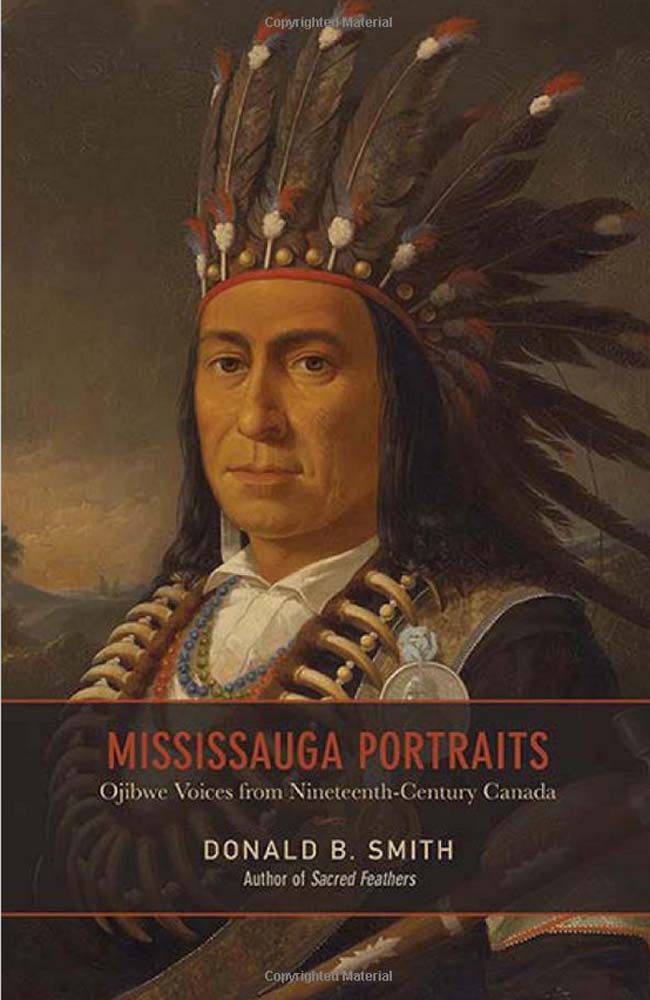Mississauga had Methodism in common
 Mississauga Portraits: Ojibwe Voices from Nineteenth-Century Canada
Mississauga Portraits: Ojibwe Voices from Nineteenth-Century Canada
by Donald B. Smith. University of Toronto Press, 2013. 457 pgs.
Reviewed by Armand Garnet Ruffo
Many years ago when I was a teenager living in Chapleau, a young historian arrived from Toronto to visit my family. He was researching a book on the life of Archibald Stansfeld Belaney, commonly known as the infamous Grey Owl. He knew that Grey Owl had lived with my Ojibwe grandmother’s parents in Biscotasing and wanted to interview her. To my mind, this has been the pattern of Dr. Donald B. Smith’s long and respected career as one of Canada’s foremost historians. He methodically seeks out the information he requires, whether through interviews or by digging through archival record, and literally leaves no stone unturned. Furthermore, he approaches his Aboriginal subjects with respect and a sensitivity that can only come from someone who has immersed himself in learning about the people of whom he writes.
To this end, Smith has done it once again in his latest book Mississauga Portraits: Ojibwe Voices from Nineteenth-Century Canada. Gathered together are eight “portraits” or profiles of prominent “Mississauga” – a term that Smith tells us was “applied by the British in the eighteenth and nineteenth century to the Ojibwe on the north shore of Lake Ontario”. To say that Smith provides an impressively detailed mini-biography of each of his subjects would be an understatement.
Moving from birth to death, each of the eight portraits stands on its own and provides a fascinating and informative glimpse of Smith’s subjects, while together functioning as chapters of the complete text and providing a panoramic view of life in the period — and not just any life because these portraits focus on remarkable leaders who in their own right fought for their people against insurmountable odds.
What cements Smith’s text together is not only that each of his portraits focuses on a prominent 19th century “Mississauga” Ojibwe – including Reverend Peter Jones/Kahkewaquonaby, Credit Head Chief Joseph Sawyer/ Nawahjegezhegwabe, Catherine Sutton/ Nahnebahnwequay, Peter Jacobs/Pahtahsega, George Henry/Maungwudaus, George Copway/Kahgegagahbowh, John Sunday/Shawundais, Henry Seinhauer/ Shahwahnegezhik – but that each of these leaders (with the exception of Catherine Sutton/ Nahnebahnwequay who was, nevertheless, an active Methodist) became a prominent minister in the Methodist church. And so the “common theme of a Methodist upbringing or spiritual encounter runs through all of these Mississauga portraits.”
Smith tells us that one of the main tenants of Methodism was education and that each of them learned English and in turn used it to speak on behalf of his or her people. And so we learn that these prominent leaders sought to integrate their Christian beliefs with the Ojibwe culture as they tried to negotiate a path for themselves and their people in the rapidly-growing British territories of Canada.
We learn, for example, that “the important Mississauga missionary and chief, Peter Jones fought for three decades to secure a full partnership between his people and the newcomers” and, yet, he could not secure a permanent land base for his people in their traditional territory on the Credit River.
From an Ojibwe perspective, many of these portraits have to be considered in the light of injustice and tragedy. Added to this is the daunting density of Smith’s writing. To put it succinctly, Mississauga Portraits: Ojibwe Voices from Nineteenth-Century Canada is not light reading, but, nevertheless, it is a fascinating read. While there are certain commonalities among the Ojibwe leaders examined, each of them is presented as a unique individual, who “reacted in diverse ways to Methodism as they worked to create a better future for themselves, their families, and their communities.”
Ultimately, it is Smith’s attention to detail that makes his book worth the read, because, as we know only too well, the complexities of the issues and events that shaped nineteenth century Canada continue to reverberate in the lives of contemporary Anishinaabe.
Armand Garnet Ruffo, Ojibwe, is an award-winning poet who teaches literature at Carleton University in Ottawa.


